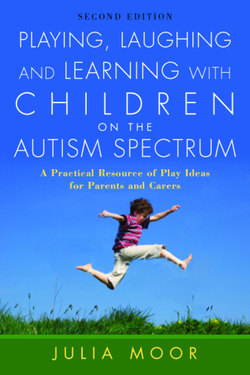Читать книгу Playing, Laughing and Learning with Children on the Autism Spectrum - Julia Moor - Страница 54
На сайте Литреса книга снята с продажи.
How do I encourage awareness that I am part of the activity?
ОглавлениеPart of this ‘healthy’ attitude is to foster an awareness right from the start that using the computer is something that is done with you, rather than you setting your child up with a game and leaving them to it.
If you are using a picture schedule, use a card for ‘computer’ that includes yourself (or shows two people) in the scenario. This reinforces for your child that using the computer at this early stage is a ‘social’ activity. A photograph of you together at the computer would work well. For children anxious about what particular activity they will be working/playing on, take a picture of the activity on the screen.
Use computer activities like any other table-top turn-taking game (see Chapter 8 on turn-taking). Remember to keep up a simple audible dialogue as your child is unable to see your face for clues about when it’s your turn. Talk about what is happening on the screen, but leave pauses for your child to respond to what he is seeing and to process what you’re saying.
Always take a look at an activity first before you try it with your child; you need to be really clear about how it works and what happens. You might decide that the spoken/written instructions on the screen may need to be supplemented by picture cue cards, for example if there is a written instruction such as ‘click on the train’, you may need a picture of a train to show your child. You may feel it would reduce your child’s stress to produce a simple picture instruction card for the activity for him to follow in a sequence.
If you’re working on a site looking at facial expressions, have a mirror ready to practise the expression, and maybe take a digital photo of you and/or your child making expressions.
Your child may need a ‘cue’ for when it’s your turn to touch the mouse, so try having a photo of each person using the computer (i.e. you, your child, a sibling) and place the photo in a mouse mat with a wallet pocket, or stand it next to the computer screen when it’s time to change turns.
You may need to supplement the activity with picture cue cards not just for using the computer, but for switching on, saving work and calming down too (see below).
It is only natural that as your child gets older and more independent (again this can only be judged by yourself, but as a rule at least over seven years), these activities can become more solitary, in short bursts, as your child becomes a more self-directed learner. The computer can then become an appropriate leisure activity in supervised sessions.
